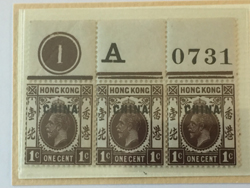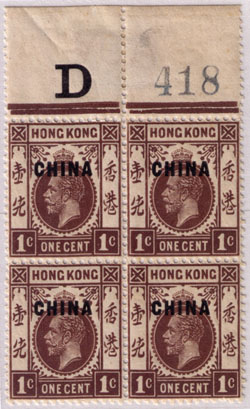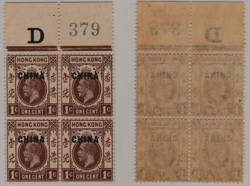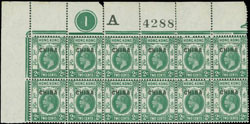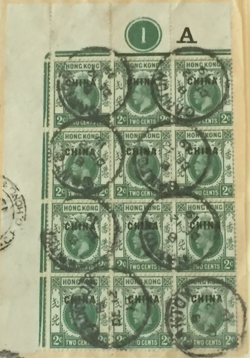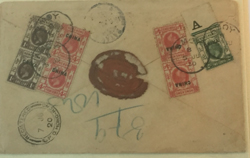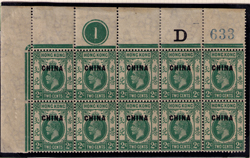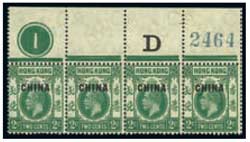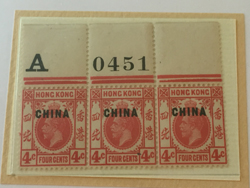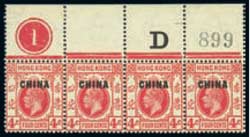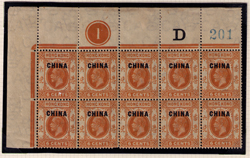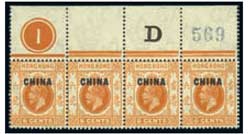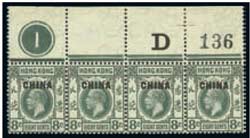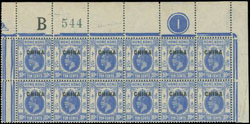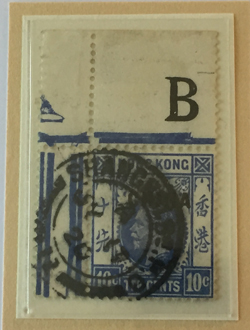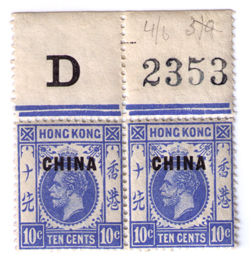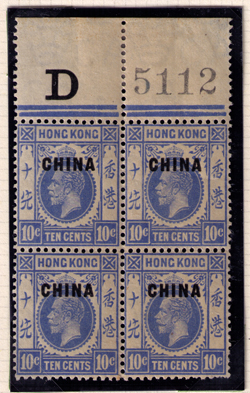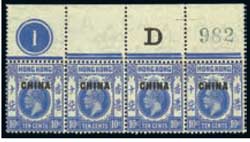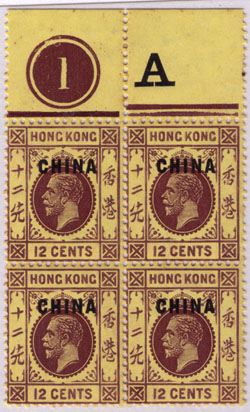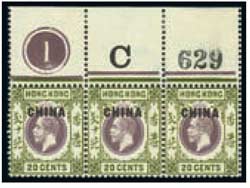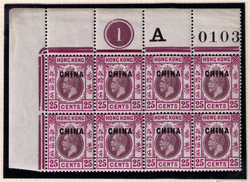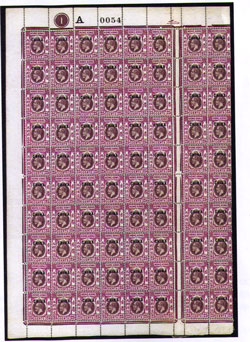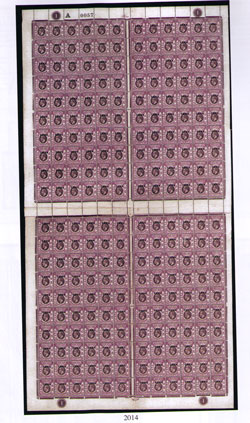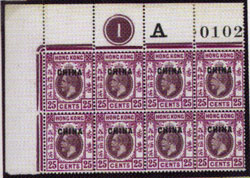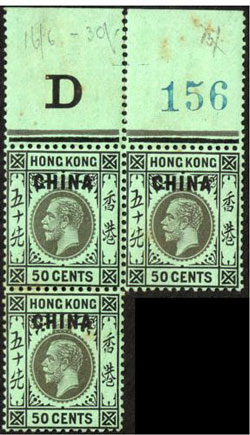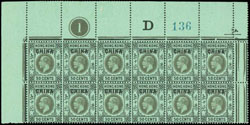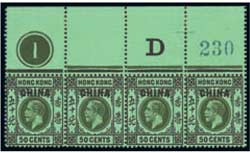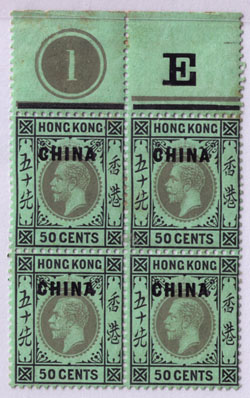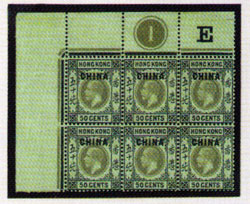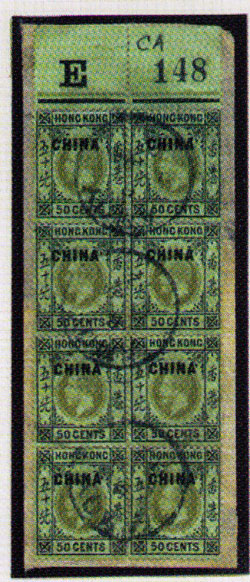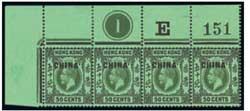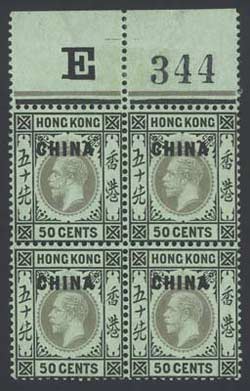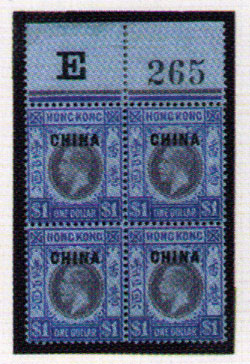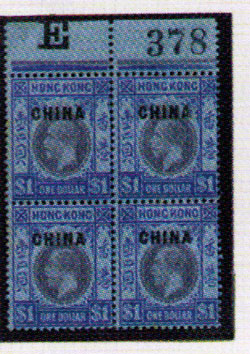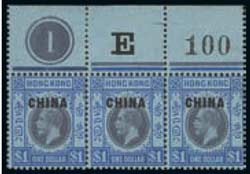Plate Numbers, Requisition Letters, and Sheet Numbers
The following information comes from Perrin:
The first consignment, dispatched in November 1916, had no requisition letters or numbers. The postmaster general of Hong Kong protested, stating that the ‘China’ series should be numbered like the normal Hong Kong issues.
This is because the sheets had to be re-issued by Hong Kong in varying quantities to the individual agencies and separately accounted for, numbering them would eliminate the need to count each individual sheet. The GPO originally did not want to do this, considering it unnecessary and uneconomic, and referred it upward for a policy decision. The higher level stated that it would be impolitic to refuse to facilitate the work of the of the colonial PMG, especially considering that all other issues of the Hong Kong postage had serial numbers. The final decision was as follows: 'There are special reasons. A lot of work is done in Hong Kong without adequate remuneration. Go ahead.' Accordingly, the second consignment in autumn of 1917 was printed with requisition letter A.
There are very few surviving requisition blocks, some printings were not recorded and dates can only be reconstructed from the incomplete evidence. The above GPO correspondence confirms that the sheets produced for the ‘China’ overprints were numbered separately from the normal Hong Kong issue. As such, the ‘China’ 25c MCA exists with requisition A, whereas the normal 25c started at letter B.
Moreover, the ‘China’ serials were printed in much bigger and thicker type (e.g. letter F is 6 mm deep and letter I is 7mm deep with numbers 4 ½ -5 mm. deep). There was also a large gap between the number and the letter (14mm from right of the letter to the first figure), unlike the normal issues where the number immediately followed the letter. The ‘China’ series also included the letter I, and in this case ‘No.’ was inserted in the gap (e.g. I. No. 1528). In the final printing, 'No.' was positioned over column 3, the serial number over column 4, and the requisition letter at the top of column 6,
The difference between the ‘China’ overprints and the normal Hong Kong issues resulted from the fact that the ‘China’ serials were printed by Somerset House instead of by De La Rue.
Requisition letters and numbers were normally printed in black except for D201 (6c) and D633 (2c) where the numbers were printed in blue and letters were printed in black.
Sheet/Serial Numbers:
Neither the Nil requisition nor the H Requisition 50c were numbered
This cover, dated April 2, 1922 from Shanghai to Berne, Switzerland is the only known example of a sheet number used on cover. In this particular instance, the 1 cent stamp probably paid the certificate of mailing fee.
First Issue Requisition Letters
Second Issue Requisition Letters
|
Value |
Color |
Requisition |
Image
|
|
1 cent |
Brown |
F
|
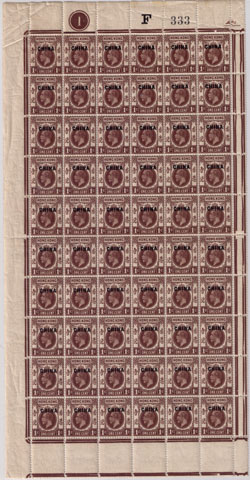 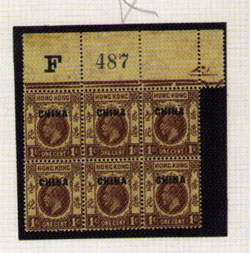 Block of 3 F 374 Strip of 4 F 90 Block of 4 F 428 |
|
1 cent |
Dark Brown |
G |
|
|
1 cent |
Dark Brown |
J |
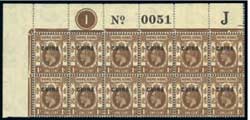 |
|
2 cents |
Green |
F |
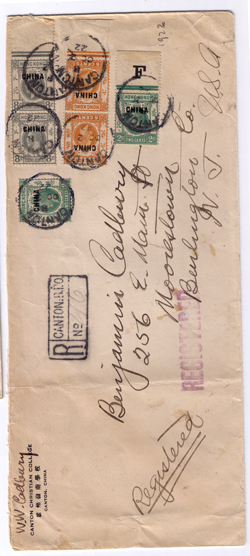 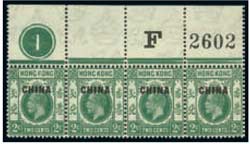 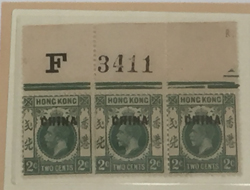 |
|
2 cents |
Blue-Green |
I |
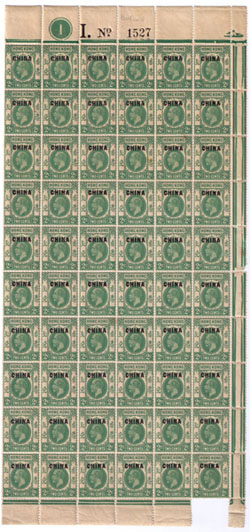 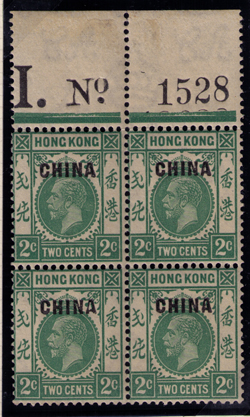 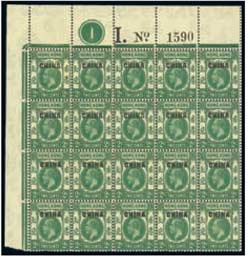 |
|
4 cents |
Carmine-Rose |
F |
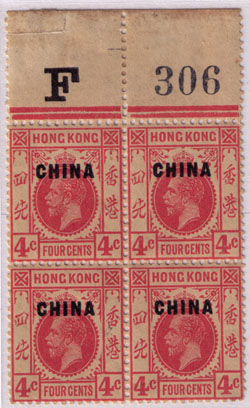 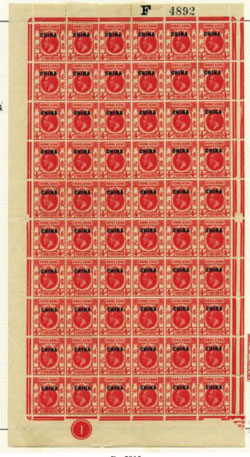 Block of 48 F 250 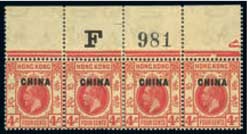 |
|
4 cents |
Carmine-Red |
I |
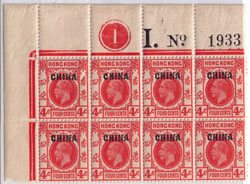 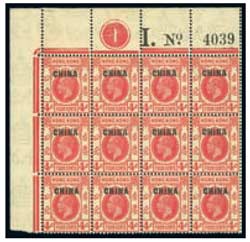 |
|
6 cents |
Orange-Yellow |
F |
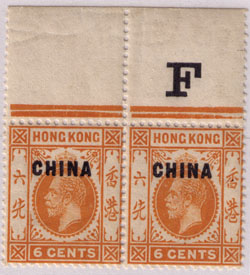 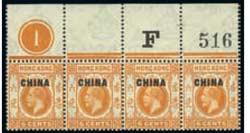 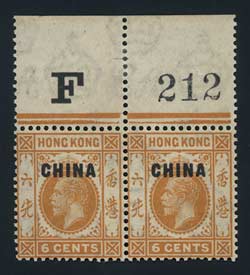 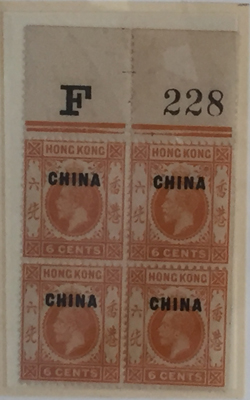 |
|
8 cents |
Grey |
F |
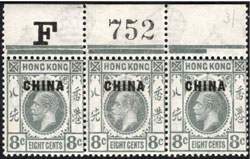 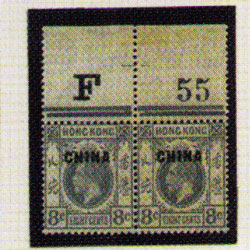 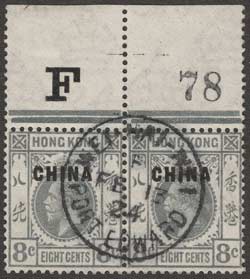 Pair F 143 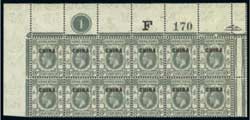 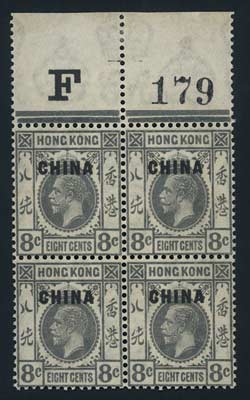 |
|
10 cents |
Pale Ultramarine |
F |
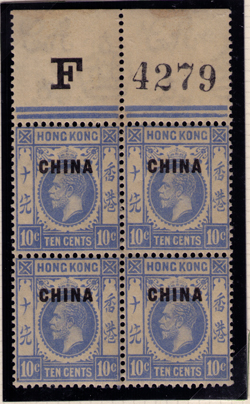 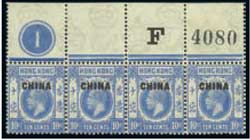 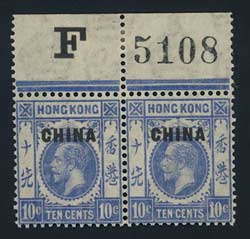 |
|
10 cents |
Bright Ultramarine |
J |
|
|
20 cents |
Dull Purple and Sage-Green |
F |
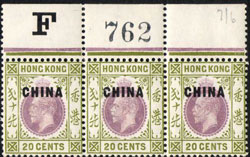 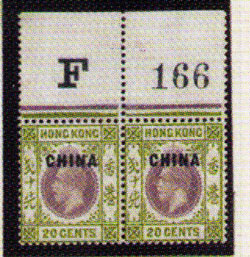 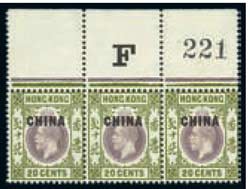 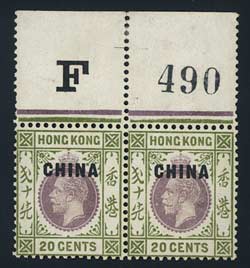 |
|
20 cents |
Reddish Purple and Sage-Green |
H |
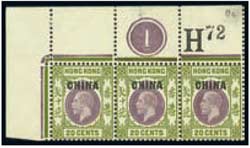 |
|
20 cents |
Purple and Deep Sage-Green |
J |
|
|
25 cents |
Dull Purple and Magenta |
F |
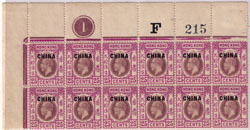 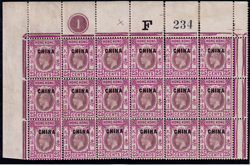 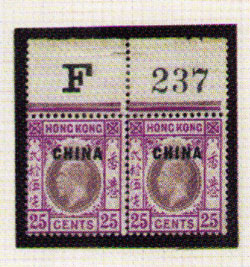 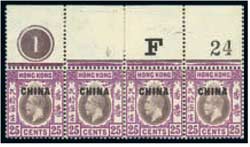 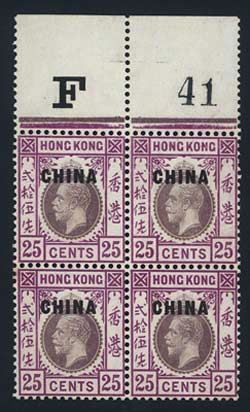  |
|
25 cents |
Brownish Purple and Magenta |
J |
      |
|
50 cents |
Dark Grey on Emerald, Emerald Back |
H |
 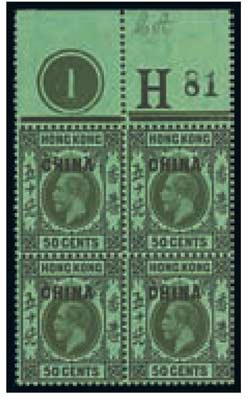 |
|
50 cents |
Bistre on Emerald, White Back |
J |
|
|
1 dollar |
Grey-Purple and Blue on Blue |
F |
|
|
1 dollar |
H |
 |
|
|
1 dollar |
Purple and Blue on Blue |
J |
|
|
2 dollars |
Carmine-Red and Olive-Bistre |
F |
|
|
2 dollars |
Scarlet and Beige Brown |
H |
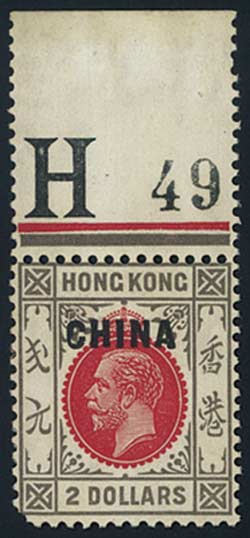  |
|
2 dollars |
Carmine-Red and Grey-Black |
J |
Plate Numbers
The stamps were printed in sheets of 240, divided into 4 panes each of 10 rows of 6 stamps and using two printing plates, one for the head of King George V, known as the head plate or vignette and a second for the frame, which was known as the duty plate. One duty plate was used for each value with the exception of the 25 cent value which was used until 1919 when it was discovered that it contained a wrong Chinese character and a new plate was made. One common head plate was used for all values and sheets exhibit just that number. Consequently the only plate number that appears on all of the China overprints is that of Head Plate Number 1 which appears on the panes above 1-2 NW and 1-5 NE and below 10-2 SW and 10-5 SE.
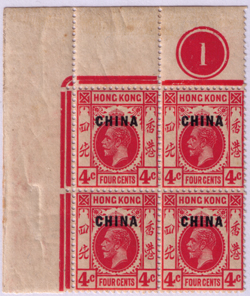
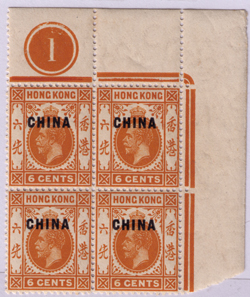
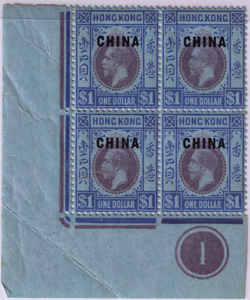
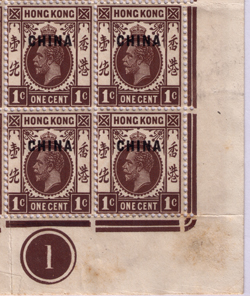
| Denomination | Image |
|---|---|
|
First |
|
| 1c | 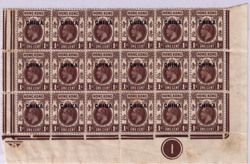 |
| 2c | |
| 4c |  |
| 6c |  |
| 8c | 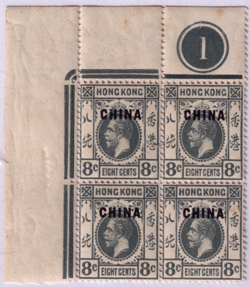 |
| 10c | 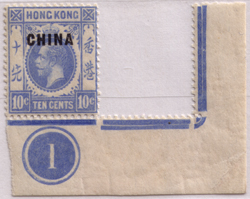 |
| 12c | 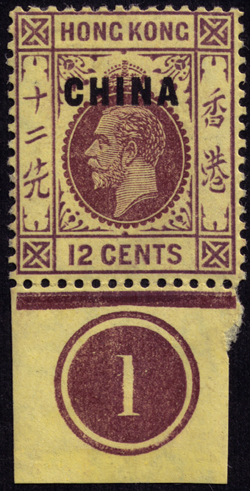 |
| 20c | 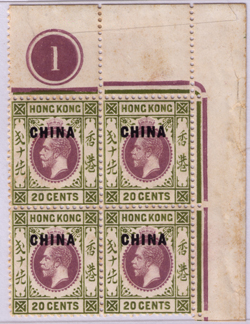 |
| 25c | 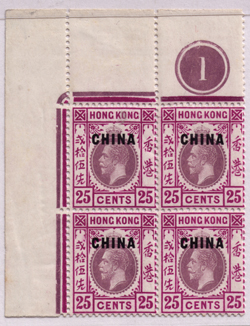 |
| 30c | |
| 50c | 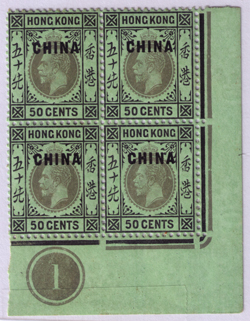 |
| $1 |  |
| $2 | 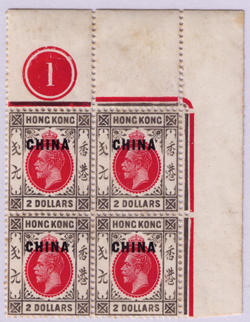 |
| $3 | |
| $5 | |
| $10 | |
| Second Issue |
|
| 1c | 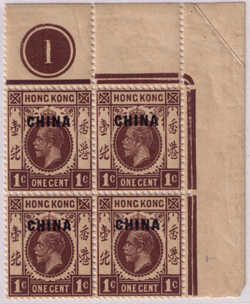 |
| 2c | 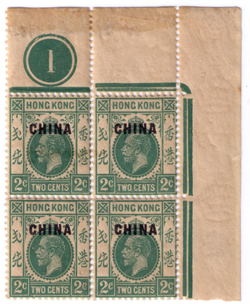 |
| 4c | 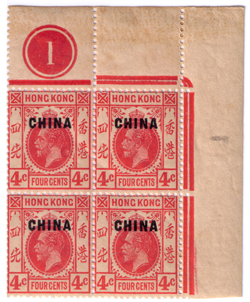 |
| 6c | 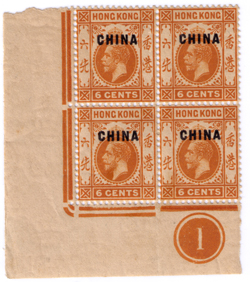 |
| 8c | 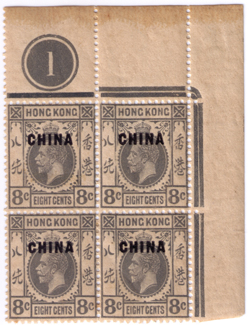 |
| 10c | 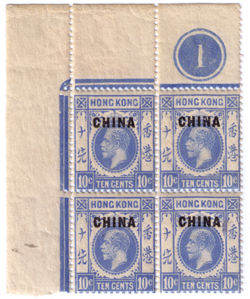 |
| 20c | 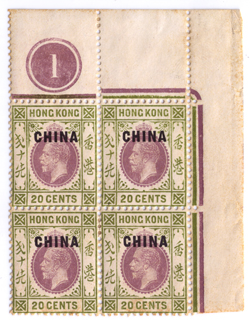 |
| 25c | 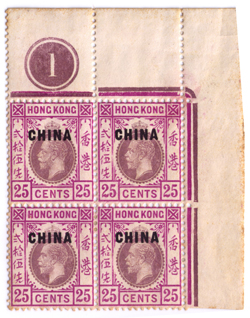 |
| 50c | 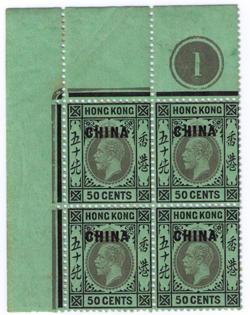 |
| $1 | 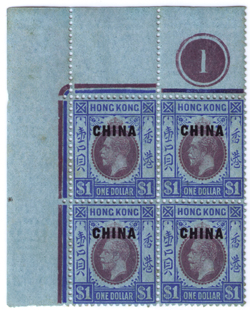 |
| $2 | 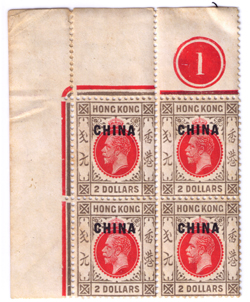 |
Plate number examples used on cover recorded to date are:
10c Shanghai 21 Sep 1921
Quantities Destroyed and Sold
After the closure of the Treaty Ports in 1922, surviving stocks of the stamps were returned to Hong Kong and shipped back to London on the S.S. Morea on 18 October 1924. After the closure of Wei Hai Wei in 1930, the surviving stocks remaining there were also returned to Hong Kong and then returned to London on 16 September 1932. All returned stocks were destroyed. Consequently an educated guess of the number of stamps used by denomination are listed below and highlights the relative scarcity of some of the values.
|
|
Quantity |
Quantity |
Presumed |
|
1c |
894,720 |
34,267 |
860,453 |
|
2c |
6,241,440 |
1,633,727 |
4,607,713 |
|
4c |
6,408,960 |
1,369,911 |
5,039,049 |
|
6c |
685,440 |
80,124 |
605,316 |
|
8c |
603,600 |
119,790 |
483,810 |
|
10c |
5,811,600 |
1,060,382 |
4,751,218 |
|
12c |
84,480 |
0 |
84,480 |
|
20c |
580,800 |
119,141 |
461,659 |
|
25c |
135,600 |
48,083 |
87,517 |
|
30c |
104,400 |
0 |
104,000 |
|
50c |
607,440 |
239,011 |
368,429 |
|
$1 |
362,400 |
138,096 |
224,304 |
|
$2 |
79,440 |
25,965 |
53,475 |
|
$3 |
6,240 |
0 |
6,240 |
|
$5 |
6,480 |
3,067 |
3,413 |
|
$10 |
6,240 |
4,437 |
1,803 |
